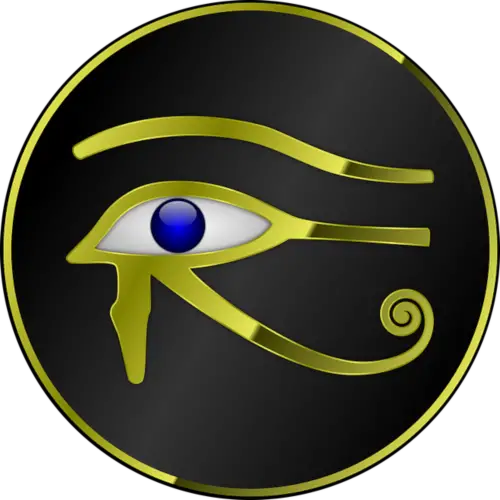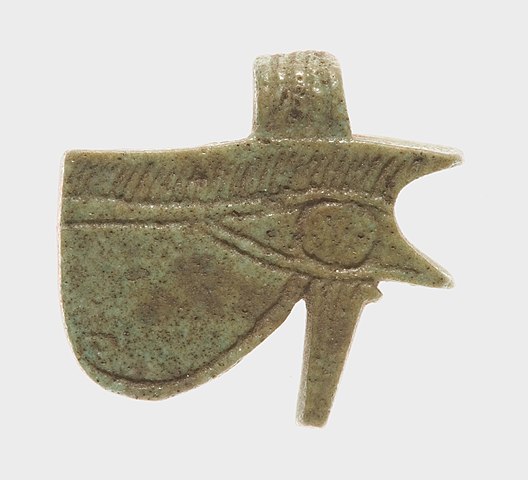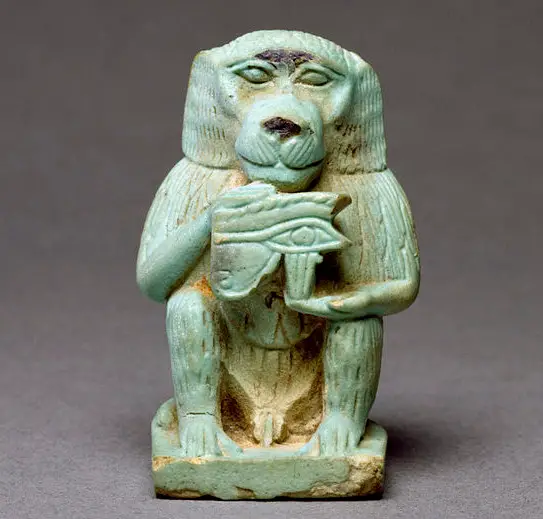When we think of Egyptian symbols, usually two icons spring to mind. They are the famous ankh motif and the iconic Eye of Horus (also called Wadjet). This symbol comprises a highly stylized eye and an eyebrow.
Dual lines extend from the bottom of the eye mimicking the facial markings of Horus’s Egyptian falcon symbol. In most ancient examples the Eye of Horus is portrayed with a blue iris.

Image by Peter Lomas from Pixabay
Its distinctive form is depicted in art, jewellery, artifacts, relics, manuscripts and frequently found in ancient Egyptian tombs and temples.
In the tomb of Tutankhamen, a gold and glass pectoral amulet depicting the Eye of Horus flanked by Lower Egypt’s cobra goddess and the vulture goddess of Upper Egypt was discovered amongst the grave goods.
Two names have been attached to the Eye of Horus symbol. Firstly it is known as the Eye of Horus and secondly, it is called the Wadjet.
These different names reflect the meaning behind the symbol, rather than its depiction. Without background context, it is impossible to correctly identify which of the meanings is intended.
Restoration, Healing and Protection
Horus is the son of Osiris and the nephew of Set. During a battle, Set murdered Osiris, Horus and Isis (his mother) began reassembling Osiris’ dismembered body and revived him as the Lord of the Underworld.
In one commonly recounted saga, Horus gave up one of his own eyes for Osiris. In another story, Horus lost his eye in an epic struggle with Set. These stories illustrate the Eye of Horus’ connection with restoration and healing.

Wedjat eye amulet
Metropolitan Museum of Art / CC0
The Eye of Horus is also a powerful protective symbol and was commonly in amulets intended to protect both the living and the dead against malignant spells while its healing power helped to fend off ill health. It also symbolizes royal power.
Egyptian legend recounts how Horus lost his left eye during his battle with Set who ripped Horus’ eye into six pieces.
Happily, Thoth the Egyptian god of writing, magic, the moon and wisdom proved able to reconstruct the eye and later returned it to Horus. Horus gave his reconstructed eye to his murdered father Osiris. This act resurrected Osiris.
Hence, the Eye of Horus symbol signifies its healing power. It was widely believed to be able to bring the dead back to life, just as it did so successfully with Osiris.

Thoth holds the Eye of Horus
Walters Art Museum / Public domain
A Measuring System
The ancient Egyptians used the eye as a funerary amulet for the deceased to protect them against evil in the underworld and to guide their eventual rebirth.
The Ancient Egyptians also used the Eye of Horus as a unit of measurement to define fractions of volume.
The Eye of Horus was combined, in several different ways to measure the unit capacity for grains, pigments and medicines. This system of measurements was designed to quantify system parts of a whole.
Recommended resources for further learning:
- More Information on the eye as a measuring system can be found here
- An overall guide covering most aspects of the eye can be found here
- An excellent overview of the eye can be found here
Reflecting On The Past
The protective power that the ancient Egyptians ascribed to the Eye of Horus is evidendent. Egyptian sailors used to paint the Eye of Horus on the bows of their boats before they set sail on arduous and often perilous voyages.
